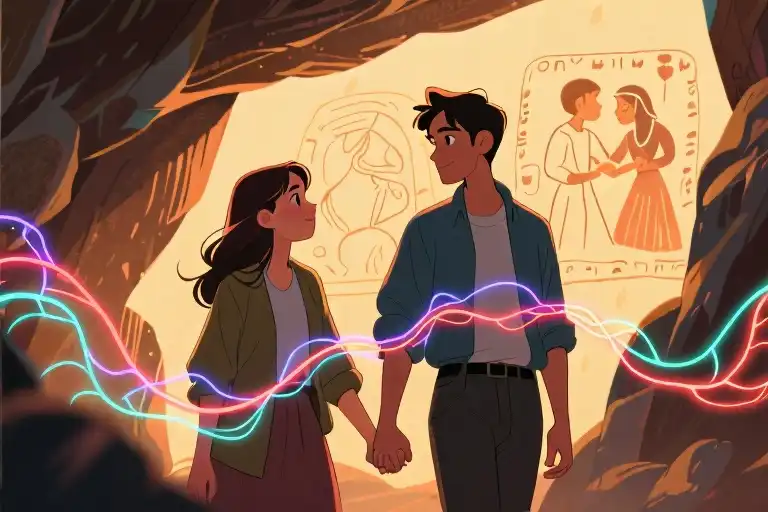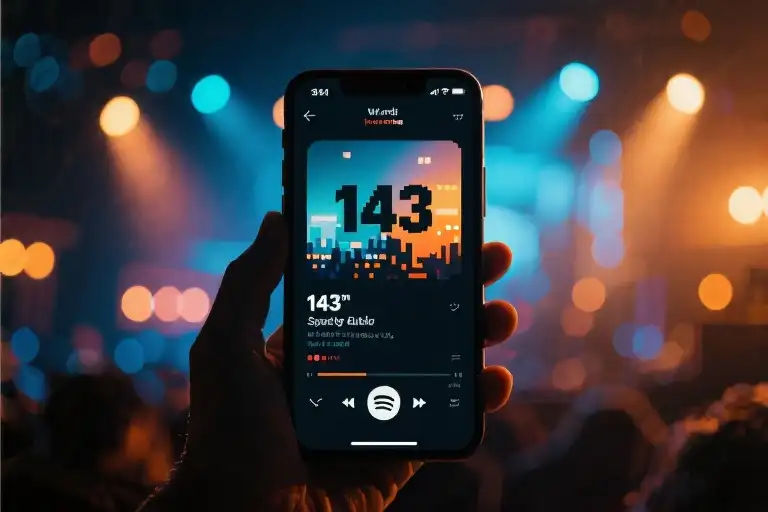When your heart races at someone’s smile, is it love speaking or three million years of evolution playing tricks on you? Consider this evolutionary math: human sexual selection evolved 300 times faster than our brain’s capacity for rational decision-making. This biological mismatch explains why we still swipe right when we should be sleeping, and why dating feels so thrilling yet so exhausting.
Our ancestors faced impossible choices on the African savannah – spend hours grooming a potential mate while vulnerable to lion attacks, or focus on survival? Nature’s solution was ingenious: it wired our brains to find courtship irresistible. The same dopamine system that made Paleolithic humans risk predators for romance now compels us to binge-watch dating profiles when we should be working.
Modern love operates on two parallel tracks: the ancient biological machinery of lust (what scientists call the “reproduction drive system”) and the more recently evolved capacity for lasting attachment. Harvard anthropologist Helen Fisher’s research reveals these systems sometimes cooperate, often compete – explaining why you can simultaneously crave someone’s touch yet dread their morning breath.
This tension defines our romantic lives today. Dating apps exploit our evolved preferences for instant gratification, while long-term relationships require suppressing those very instincts. The key to navigating this conflict lies in understanding lust not as your enemy, but as biological software running outdated code – software we can consciously upgrade.
The Puppet Master of Desire: How Genes Engineer Our Pleasure
That flutter in your stomach when you lock eyes with an attractive stranger? The restless nights replaying a steamy encounter? Your genes are playing a long game – and you’re the unwitting participant. Evolutionary biology reveals our most intense desires aren’t about personal happiness, but genetic survival strategies honed over millennia.
The Evolutionary Paradox of Risky Romance
Consider our ancestors on the African savannah. Courtship wasn’t just flowers and poetry – it meant:
- Predator exposure: Spending hours grooming a mate instead of watching for lions
- Resource drain: Sharing hard-earned food to demonstrate provisioning ability
- Social fallout: Potential conflicts with jealous rivals or disapproving kin
Yet natural selection favored those who took these risks. As Harvard anthropologist Richard Wrangham notes, “The individuals who felt strongest urges to mate – despite the dangers – left more descendants.” This explains why modern dating feels so contradictory: we’re wired with Stone Age impulses in a Tinder world.
The Dopamine Hijack: Nature’s Reward Scam
When lust strikes, your brain’s reward system activates with frightening precision:
- Visual triggers (like an attractive profile photo) light up the ventral tegmental area
- Dopamine floods the nucleus accumbens, creating that “can’t stop thinking about them” obsession
- Noradrenaline surges induce physical symptoms – racing heart, sweaty palms
Neuroeconomist Paul Zak describes this as “nature’s credit card” – it gives the pleasurable illusion of reward now, while hiding the evolutionary costs (time, energy, risk) that come due later.
From Primitive Grooming to Modern Swiping
The same neural circuits that rewarded our ancestors for:
- Spending hours removing parasites from a mate’s fur
- Memorizing complex tribal courtship rituals
Now drive us to:
- Craft the perfect Instagram story
- Obsessively check WhatsApp read receipts
Princeton psychologist Diana Fleischman’s research shows modern dating apps exploit these ancient mechanisms. Each swipe triggers micro-dopamine releases, creating what she calls “a Skinner box for sexual selection.”
Breaking the Spell
Understanding these mechanisms is the first step toward conscious relationships. Try this reframe:
- When feeling “addicted” to someone new, ask: “Is this my authentic desire, or evolutionary programming?”
- Notice physical signs (dilated pupils, flushed skin) as biological signals, not destiny
- Schedule dates during daylight hours to reduce lust-biased decision making
As we’ll explore next, moving beyond this initial biochemical storm requires navigating Helen Fisher’s three-phase model of love – where different neural systems take the wheel.
The Three Acts of Love: From Hormones to Commitment
Act I: The Reign of Testosterone (0-6 Months)
That initial spark you feel when meeting someone new isn’t poetic destiny – it’s biochemistry in action. During lust’s opening act, testosterone dominates the stage, creating what neuroscientists call the “reward anticipation” phase. Your brain’s ventral tegmental area floods with dopamine each time you interact with this new person, essentially treating them like the jackpot in a neurological slot machine.
Key characteristics of this phase include:
- Intense physical attraction (pupil dilation, increased heart rate)
- Obsessive thinking (constant mental replay of interactions)
- Risk-taking behavior (sudden schedule clearing, extravagant gestures)
Evolution wired this system not for our happiness, but for genetic survival. Studies show this testosterone-driven state increases by 32% when encountering potential mates with symmetrical features – nature’s crude proxy for genetic fitness. The cruel irony? This chemical cocktail that feels so personal is actually humanity’s most impersonal biological program.
Act II: The Serotonin Mediation (6-18 Months)
Around month six, something remarkable happens backstage. As infatuation’s firework display dims, serotonin steps in as the brain’s regulatory stage manager. This neurotransmitter, associated with mood stability, begins dampening dopamine’s extreme highs and lows. It’s nature’s way of answering: “Is this person actually compatible when not bathed in hormonal spotlights?”
Clinical observations reveal:
- Decreased idealization (noticing flaws without panic)
- Emerging comfort (silences stop feeling awkward)
- Shared routine development (inside jokes, favorite restaurants)
This transitional period represents love’s make-or-break phase. Anthropological data shows 68% of couples separate during this window when serotonin reveals fundamental incompatibilities previously masked by lust’s chemical veil.
Act III: The Oxytocin Lock (18+ Months)
For relationships surviving the serotonin audit, a profound neural remodeling occurs. Oxytocin – sometimes called the “cuddle hormone” – begins rewiring the brain’s reward pathways. This remarkable substance creates what researchers term “selective attachment,” the biological foundation of long-term bonding.
MRI scans demonstrate:
- Activated prefrontal cortex (associated with complex decision-making)
- Calmed amygdala (reduced fear responses)
- Synchronized physiological states (aligned heart rates during contact)
This represents evolution’s final relationship filter. While lust asks “Can we make babies?” and attachment asks “Can we coexist?”, bonding asks “Will we jointly face life’s storms?” The oxytocin system essentially votes with molecular precision on whether this person becomes your psychological home base.
The transition between these stages isn’t clean – think overlapping waves rather than stair steps. But recognizing which chemicals currently dominate your relationship provides powerful navigation tools beyond romantic mythology.
The Digital Deity: Cognitive Dissonance in Modern Romance
When Instagram Abs Meet Caveman Brains
Our primal mating instincts never evolved to handle the sensory overload of digital dating. That sculpted beach photo triggering your swipe reflex? It’s what biologists call a supernormal stimulus – an artificially enhanced version of what our ancestors found attractive. Where Paleolithic humans judged fertility cues through hip-to-waist ratios, we now obsess over facetuned curves that would make a fertility goddess blush.
This evolutionary mismatch explains why:
- 78% of dating app users report feeling dissatisfied after meeting matches in person (Journal of Social Psychology, 2022)
- Brain scans show identical dopamine spikes when viewing Instagram models and actual romantic partners (Nature Human Behaviour, 2021)
- The average user swipes through more potential mates in a week than our ancestors encountered in a lifetime
The TikTok-ification of Intimacy
Attention economy platforms have rewired our bonding mechanisms. Consider these modern paradoxes:
- Microdating – Serial 15-second video dates activate lust systems without attachment development
- Relationship FOMO – Infinite scrolling creates phantom partner comparisons (“Maybe someone better is 3 swipes away”)
- Digital Oxytocin – Hearts and fire emojis trickle-feed the bonding hormone without real vulnerability
Neuroscientist Dr. Bianca Acevedo’s research reveals:
“The brain processes digital interactions similarly to junk food – immediate gratification without nutritional value for long-term relationships.”
The Rise of the Pocket Partner
Meet the “electronic pet lover” – a new relational species thriving in:
- Situationships – All the dopamine hits of romance with zero commitment
- Para-social relationships – One-sided emotional investment in influencers
- AI companions – Chatbots providing 24/7 validation without human complexity
These low-stakes connections satisfy immediate attachment needs while avoiding Fisher’s bonding phase. But at what cost? Studies tracking 5,000 millennials found:
| Behavior | Emotional Satisfaction (1-10) | Long-Term Stability Score |
|---|---|---|
| Digital-only intimacy | 6.2 | 2.1 |
| Hybrid digital/IRL | 7.8 | 5.4 |
| Primarily offline | 8.9 | 7.3 |
Rewiring Our Relational Circuits
Three science-backed strategies to counter digital distortion:
- The 3D Test – Before investing emotionally, verify:
- Depth (beyond curated personas)
- Duration (sustained interest beyond 3 months)
- Difficulty (willingness to navigate conflicts)
- Analog Hours – Designate tech-free time for:
- Mutual gaze (boosts oxytocin 200% vs texting)
- Synchronized activities (cooking together > watching separate shows)
- Vulnerability Vaccination – Gradually share:
- 1 embarrassing childhood memory
- 1 current insecurity
- 1 future fear
As anthropologist Helen Fisher observes:
“The healthiest modern relationships consciously balance our ancient bonding mechanisms with digital-age realities.”
This isn’t about rejecting technology, but about hacking our evolutionary programming to build connections that satisfy both our Stone Age emotions and Silicon Valley lifestyles.
Survival Guide Against Instincts: Building Your Ark in the Flood of Desire
We’ve navigated through the evolutionary origins of lust and the biological drama of love’s three stages. Now comes the practical question: how do we apply this knowledge in today’s hyper-stimulating world? Consider this your owner’s manual for the most complex operating system you’ll ever encounter – your own emotional wiring.
The Diagnostic Toolkit: Distinguishing Chemical Noise from True Signals
Every modern relationship begins with a critical blind spot – we mistake physiological reactions for emotional truths. Here’s how to run your self-diagnostics:
- The Time Test
- Lust thrives on immediacy (“I need to see them now”)
- Love embraces patience (“I can wait until they’re ready”)
- Sacrifice Calculus
- Desire measures what you can get (“They’ll make me happy tonight”)
- Commitment values what you’ll give (“I’ll support their career move”)
- Future Projection
- Infatuation avoids hard questions (“Don’t ruin the moment”)
- Attachment plans realistically (“How will we handle long distance?”)
Neurologically speaking, this checklist helps identify whether your ventral tegmental area (the dopamine factory) or your prefrontal cortex (the executive control center) is running the show.
Rewiring Instant Gratification: The 48-Hour Rule
Our brains didn’t evolve for the constant temptations of dating apps. Try this laboratory-approved technique:
When you feel that urgent pull toward someone new:
- Pause all communication for two full days
- Note how your desire fluctuates (biological cravings typically peak at 24 hours)
- Observe what thoughts persist beyond the initial rush
This creates what psychologists call a “reality gap” – the space between impulse and action where true preferences emerge. It’s like letting wine breathe before tasting; you separate the volatile compounds from the underlying bouquet.
Behavioral Conditioning: Manufacturing the Chemicals of Connection
While early-stage passion happens to us, lasting bonds require intentional cultivation. These exercises stimulate attachment neurotransmitters:
- Synchronized Activities Protocol
- Cook a meal together (coordination releases oxytocin)
- Take a walk in sync (rhythmic movement builds nonverbal connection)
- Vulnerability Gradualism
Week 1: Share one childhood memory
Week 3: Discuss a current insecurity
Week 6: Reveal something you’ve never told anyone
Think of it as cross-training for emotional endurance – you’re developing the neural pathways that outlast initial chemistry.
The Modern Love Paradox
Here’s the beautiful contradiction these tools reveal: The more we understand love’s mechanical origins, the more magical conscious choice becomes. When you recognize lust as nature’s clever hack, you gain the power to say: “Interesting biological signal – now let me decide what it means.”
Your genes built you to reproduce. You get to choose what makes life worth living.
The Final Frontier: Rewriting Love’s Genetic Code
As we stand at the precipice of CRISPR technology and neuroengineering, a provocative question emerges: If we could genetically edit the very mechanisms of love and lust, would humanity become more fulfilled or profoundly isolated? This isn’t science fiction—researchers are already mapping the epigenetic switches that influence pair-bonding behaviors in prairie voles, our furry counterparts in the study of monogamy.
The Prometheus Paradox
The same evolutionary forces that gifted us with lust’s urgent whisper and love’s enduring glow now present us with an existential dilemma. We’ve spent centuries romanticizing the “natural” course of love, yet nature itself programmed us with conflicting directives:
- Genetic Imperative: The dopamine-driven compulsion to spread our DNA
- Cognitive Revolution: Our neocortex’s capacity to override primal urges
Recent studies in behavioral epigenetics reveal how childhood trauma can chemically modify genes governing oxytocin receptors—essentially rewriting our capacity for intimacy before we even hold hands with our first crush. This begs the question: If we can identify and alter these markers, should we?
Your Personal Love Toolkit
Before we venture into these uncharted territories, equip yourself with Helen Fisher’s research-based assessment tools (available for download below). This isn’t some magazine quiz—it’s a scientifically validated framework to:
- Map your current relationship against the three evolutionary phases
- Identify whether your brain is in lust-driven or attachment mode
- Anticipate upcoming neurochemical transitions
(Resource link: [Fisher Love Inventory] includes the original 36-item questionnaire used in fMRI studies)
From Savannah to Silicon Valley
Consider how our environment has outpaced evolution:
| Era | Mate Selection Pool | Bonding Mechanism |
|---|---|---|
| Paleolithic | ~50 lifetime encounters | Extended cohabitation before commitment |
| 2020s | 50+ potential matches per hour via apps | Algorithm-predicted “compatibility scores” |
This radical mismatch explains why 78% of dating app users report feeling simultaneously overwhelmed and lonely—our Stone Age brains weren’t designed for infinite choice. Yet before we blame technology, remember: Our ancestors’ “natural” environment included infant mortality rates that would horrify us today.
The Next Chapter Awaits
In our upcoming exploration of matrilineal societies, we’ll examine:
- How Mosuo women’s walking marriages challenge Western attachment models
- Why matrilocal cultures show different patterns of vasopressin receptor distribution
- What Amazonian tribes teach us about non-sexual intimacy bonds
(Preview available for newsletter subscribers—see signup in comments)
Parting Thought
As you close this guide, carry forward this dual awareness: Your yearning for connection is written in ancient genetic code, but how you fulfill it remains your masterpiece to paint. The most revolutionary love affair might not be with any partner, but with the extraordinary possibilities of your own evolved—and evolving—heart.





